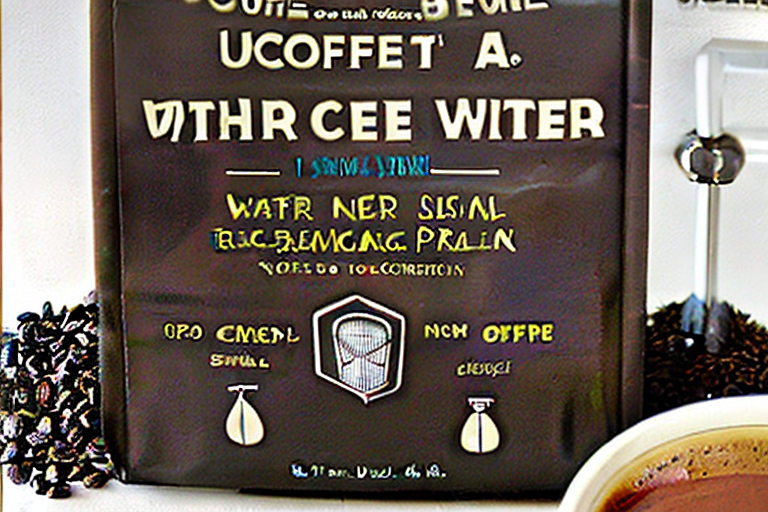Introduction: The Unsung Hero of Coffee Brewing
Beyond the beans themselves, water, often overlooked, plays a crucial role in crafting the perfect cup of coffee. It’s the unsung hero of coffee brewing, the invisible hand that shapes the final flavor profile. Water isn’t merely a solvent; it’s a dynamic ingredient that interacts intimately with coffee compounds, extracting the delicate flavors and aromas that define your brew. This guide delves into the chemistry of coffee brewing water, exploring its impact on coffee and providing practical advice for optimizing your brewing process, ultimately elevating your coffee experience from ordinary to extraordinary.
Think of coffee brewing like cooking; you wouldn’t use tap water to make a delicate sauce, would you? Similarly, the water you use for coffee significantly impacts the final taste. Variables like mineral content, water hardness, and alkalinity all play a role in how coffee compounds dissolve and interact, influencing the balance of acidity, sweetness, bitterness, and body. Mastering water chemistry is key to unlocking your coffee’s full potential, allowing you to brew consistently delicious cups that truly reflect the nuances of your chosen beans.
World Barista Championship competitors meticulously adjust their water profiles, highlighting the importance of water in professional coffee brewing. They utilize tools like TDS meters to measure total dissolved solids and carefully balance minerals to achieve specific flavor profiles. Water interacts with coffee grounds during extraction, pulling out desirable compounds like sugars, acids, and aromatic oils. The mineral composition of your water directly influences this extraction process. For example, magnesium ions enhance the perception of acidity and sweetness, contributing to a brighter, more complex cup.
Calcium, on the other hand, contributes to body and mouthfeel, creating a richer, more substantial brew. Understanding these interactions allows you to tailor your coffee brewing water to highlight specific characteristics of different coffee origins and roasts. A light roast Ethiopian Yirgacheffe might benefit from water with higher magnesium levels to accentuate its delicate floral aromas and citrusy acidity, while a darker, more robust Sumatran Mandheling might thrive with higher calcium levels to enhance its full body and earthy notes.
Optimizing your coffee water involves understanding its current state and adjusting it accordingly. Testing your water with a TDS meter is the first step in this process. This will give you a baseline understanding of your water hardness and total dissolved solids. From there, you can explore filtration methods like activated carbon filters to remove chlorine and other off-flavors, or reverse osmosis systems to create a blank canvas for precise mineral additions. By understanding the role of water chemistry coffee, you can manipulate variables like water hardness and alkalinity to achieve optimal coffee extraction and unlock the full potential of your coffee beans. Whether you’re a seasoned barista or a home brewing enthusiast, mastering water chemistry is a game-changer in your pursuit of the perfect cup.
Water Chemistry 101: Minerals and Their Impact
Water’s mineral content acts as a crucial determinant of coffee’s final flavor profile, far beyond simply being a neutral solvent. The specific types and concentrations of minerals present in your coffee brewing water directly influence the extraction process and the resulting taste. Calcium, for example, tends to enhance the sweetness and body of the coffee, contributing to a more rounded and satisfying mouthfeel. Magnesium, on the other hand, plays a vital role in accentuating the acidity and complexity, bringing out brighter and more nuanced flavors.
These minerals actively participate in the chemical reactions that occur during brewing, impacting which compounds are dissolved and how they interact with our taste buds. Understanding these interactions is a cornerstone of mastering coffee brewing. Bicarbonates present in coffee brewing water act as a buffer, influencing the overall acidity of the final brew. They neutralize acids, effectively raising the pH level. The amount of bicarbonates present directly impacts the perceived brightness and sharpness of the coffee; higher levels can mute acidity, leading to a flatter, less vibrant cup.
Conversely, water with very low bicarbonate levels may result in an overly acidic and potentially sour-tasting coffee. This buffering capacity is particularly important to consider when brewing coffees known for their high acidity, such as those from certain regions of Ethiopia or Kenya. Achieving the right balance ensures a harmonious and well-rounded flavor profile. Ideal ranges exist for each of these key minerals in coffee brewing water, though these ranges can vary depending on the specific coffee beans, roast level, and brewing method.
While there’s no single ‘perfect’ water, general guidelines suggest aiming for a calcium concentration between 50-100 ppm, magnesium between 30-50 ppm, and bicarbonates between 40-75 ppm. Total Dissolved Solids (TDS), a measure of the total mineral content, is often targeted between 150-250 ppm for optimal coffee extraction. A TDS meter is an invaluable tool for measuring these levels. Deviations from these ranges can lead to noticeable flavor defects, highlighting the importance of precise water control.
Imbalances in coffee water minerals can lead to undesirable flavors that mask the coffee’s true potential. For instance, excessive calcium can create a chalky or metallic taste, diminishing the coffee’s clarity and vibrancy. High magnesium levels, while contributing to acidity, can also result in an unpleasant bitterness if not balanced by other minerals. Furthermore, high levels of chloride in the water, often due to chlorination, can create medicinal or plastic-like off-flavors. Addressing these imbalances through water filtration or mineral adjustments is crucial for achieving consistent and delicious coffee.
Finding the right coffee water minerals balance is therefore key to unlocking your coffee’s full potential and consistently brewing exceptional cups. Experimentation and careful measurement are essential. Tools like TDS meters and water testing kits allow you to analyze your existing water supply and make informed decisions about filtration and mineral supplementation. You can even use mineral additives such as Epsom salts (magnesium sulfate) or baking soda (sodium bicarbonate) to precisely adjust the mineral content and optimize coffee extraction for different bean origins and roast profiles. Ultimately, mastering water chemistry for coffee brewing is a journey of continuous refinement and discovery.
Hardness, Alkalinity, and Extraction Dynamics
Water hardness, primarily determined by the concentration of calcium and magnesium ions, plays a pivotal role in coffee extraction dynamics. These minerals interact with coffee compounds, influencing how readily flavors and aromas are released. Hard water, rich in these minerals, can impede extraction, leading to an under-extracted brew characterized by sour and undesirable sharp notes. Imagine brewing a delicate Ethiopian Yirgacheffe with excessively hard water; the nuanced floral and citrus notes might be masked by a dominant sourness, diminishing the coffee’s true potential.
Conversely, soft water, lacking these minerals, can lead to over-extraction, resulting in a bitter, hollow cup. A rich Sumatran Mandheling, brewed with overly soft water, could lose its characteristic earthy and chocolatey notes, replaced by an unpleasant bitterness. Therefore, finding the right balance in water hardness is crucial for optimal coffee brewing. Testing your water with a TDS (Total Dissolved Solids) meter is the first step towards understanding its mineral composition. This digital tool provides a numerical value representing the total concentration of dissolved minerals, giving you a baseline understanding of your water’s hardness.
Further analysis with a water testing kit can reveal the specific concentrations of individual minerals, enabling more precise adjustments. Beyond the general effects of hardness, the specific roles of calcium and magnesium contribute uniquely to the final cup. Calcium enhances sweetness and body, adding a desirable mouthfeel to the brew. Think of the satisfying weight and texture of a well-extracted Guatemalan Antigua; calcium plays a significant role in achieving this. Magnesium, on the other hand, accentuates acidity and complexity, bringing out the brighter notes in the coffee.
A Kenyan coffee, known for its vibrant acidity, benefits from the presence of magnesium, which amplifies its inherent fruit-forward characteristics. Understanding this interplay allows baristas and coffee enthusiasts to fine-tune their brewing water for specific coffee origins and roast profiles. For instance, a light roast might benefit from slightly harder water to balance its higher acidity, while a dark roast might thrive with softer water to avoid excessive bitterness. Alkalinity, related to bicarbonate levels, acts as a buffer against acidity.
Bicarbonates neutralize some of the coffee’s acids, preventing an overly sharp taste. Maintaining the correct alkalinity level is crucial, as too high alkalinity can lead to a flat, lifeless cup, while too low alkalinity can result in an excessively acidic and unpleasant brew. Water filtration methods, such as using a Brita filter or a more specialized reverse osmosis system, can help adjust water hardness and alkalinity to achieve the ideal balance for coffee brewing. These filtration methods, combined with the targeted addition of minerals like Epsom salts (magnesium sulfate) or baking soda (sodium bicarbonate), allow for precise control over the water profile, empowering you to craft the perfect cup every time. By understanding the intricacies of water chemistry and its impact on coffee extraction, you can unlock the full potential of your beans and elevate your coffee brewing experience to new heights.
Filtering Your Way to Better Coffee
Improving your coffee brewing water quality is achievable through various filtration methods, each offering a unique approach to refining your water profile. Activated carbon filters represent a common and cost-effective solution, primarily targeting chlorine, chloramine, and other organic impurities that can impart undesirable flavors to your brew. These filters work by adsorbing these compounds, effectively polishing the water without drastically altering its mineral composition. Conversely, reverse osmosis (RO) systems offer a more comprehensive purification process, stripping the water of almost all minerals and dissolved solids.
This results in essentially pure H2O, providing a blank canvas for crafting your ideal coffee brewing water. While RO offers unparalleled control, it’s crucial to remember that coffee extraction relies on the interaction between water and coffee bean constituents; therefore, RO water necessitates remineralization for optimal results. Each filtration method presents distinct advantages and disadvantages. Activated carbon filtration shines in its simplicity and affordability. It’s a practical choice for those seeking to remove off-flavors without investing in complex equipment or significantly altering the water’s inherent mineral balance.
Many readily available pitcher filters and faucet attachments utilize activated carbon, making it an accessible entry point for improving coffee brewing water. However, activated carbon filters have a limited capacity and require regular replacement to maintain their effectiveness. They also do not address water hardness or alkalinity issues, which can significantly impact coffee extraction. For instance, if your water is naturally very hard, an activated carbon filter alone won’t resolve the potential for under-extraction and muted flavors.
Reverse osmosis, on the other hand, provides the ultimate level of control over your coffee brewing water chemistry. By removing virtually all dissolved solids, RO allows you to precisely reintroduce specific coffee water minerals in desired concentrations. This level of customization is particularly appealing to coffee enthusiasts and professionals seeking to optimize coffee extraction for various bean origins and roast levels. However, the initial investment for an RO system can be substantial, and the process requires additional steps, including remineralization.
Furthermore, RO systems typically produce wastewater, raising environmental concerns for some users. The need for remineralization also introduces another layer of complexity, requiring a thorough understanding of coffee water minerals and their impact on flavor. Beyond activated carbon and reverse osmosis, other filtration methods, such as ion exchange and granular media filters, offer alternative solutions for specific water quality issues. Ion exchange filters can target specific ions, such as calcium and magnesium, to reduce water hardness.
Granular media filters, like sand filters, effectively remove sediment and particulate matter. The selection of the most appropriate water filtration method hinges on a comprehensive understanding of your existing water quality, your budget, and your desired level of control over coffee brewing water chemistry. Testing your water with a TDS meter and a water hardness test kit provides valuable insights for making informed decisions. Remember to consider both the initial cost of the filtration system and the ongoing maintenance expenses, such as filter replacements.
Ultimately, choosing the right water filtration method is a crucial step in optimizing your coffee brewing process. Whether you opt for the simplicity of activated carbon or the precision of reverse osmosis, the goal remains the same: to provide a clean, balanced foundation for extracting the best possible flavors from your coffee beans. Experimenting with different filtration methods and remineralization strategies can unlock new dimensions of flavor and complexity in your coffee, elevating your brewing experience to new heights. Don’t be afraid to explore different options and find the perfect water profile that complements your favorite coffee origins and brewing techniques. Understanding the interplay between water chemistry coffee and coffee extraction is key to achieving consistently delicious results.
Crafting the Perfect Water Profile
Once you understand your water’s inherent characteristics, you unlock the ability to tailor it precisely to your coffee. Mineral additives, such as Epsom salts (magnesium sulfate) and baking soda (sodium bicarbonate), become tools for sculpting the ideal coffee brewing water profile. This isn’t about blindly adding minerals; it’s about understanding how each element interacts with the coffee during coffee extraction. For instance, magnesium enhances perceived acidity and highlights brighter, fruitier notes, making it a valuable addition for light roasts.
Sodium bicarbonate, on the other hand, can soften harsh edges and round out the body, beneficial for darker roasts or coffees with inherent bitterness. The key is to approach mineral additions with a scientific mindset, carefully measuring and documenting the impact on the final brew. This level of control elevates coffee brewing from an art to a science-informed craft. Specific recipes for coffee water minerals exist, tailored to different coffee origins and roast levels. A light roast Ethiopian Yirgacheffe, known for its delicate floral and citrus notes, might benefit from a water profile with a slightly elevated magnesium concentration (e.g., 40-50 ppm) to accentuate its acidity and brightness.
Conversely, a dark roast Sumatran Mandheling, often characterized by earthy and chocolatey notes, could be better suited to a more balanced profile with a moderate level of both calcium and magnesium (e.g., 60 ppm and 30 ppm, respectively) to showcase its inherent body and reduce any potential harshness. These are starting points, of course, and experimentation is crucial. Using a TDS meter to measure the total dissolved solids and carefully tasting the resulting brews will help refine your approach.
The role of water hardness and alkalinity cannot be overstated when optimizing coffee water. Hard water, with high concentrations of calcium and magnesium, can hinder coffee extraction, leading to under-extracted, sour-tasting coffee. This is because the minerals can bind to coffee compounds, preventing them from fully dissolving. Soft water, on the other hand, can over-extract, resulting in bitter and hollow-tasting coffee. Alkalinity, primarily due to bicarbonates, acts as a buffer, neutralizing acids in the coffee.
High alkalinity can lead to a flat, muted flavor profile, while low alkalinity can result in an overly acidic brew. Understanding these relationships is crucial for achieving optimal coffee extraction. Beyond simply adding minerals, consider the source water and the necessity of water filtration. Even if your tap water has acceptable mineral levels, it may contain chlorine, chloramine, or other impurities that can negatively impact the taste of your coffee. An activated carbon filter is an essential first step in removing these unwanted elements.
For those seeking ultimate control, reverse osmosis (RO) systems provide a blank canvas by stripping the water of virtually all minerals, allowing for precise remineralization. However, RO systems can be expensive and require careful maintenance. The choice of filtration method depends on your budget, water quality, and desired level of control. Regular testing of your water, both before and after filtration, is essential to ensure consistent results. By actively managing your water, you transform it from a passive ingredient into an active contributor to your coffee’s flavor journey.
This involves not only understanding water chemistry coffee but also embracing a systematic approach to coffee brewing. Experiment with different mineral additions, carefully monitor the TDS levels, and, most importantly, taste the results. Keep detailed notes on your brewing parameters, water profiles, and sensory evaluations. Over time, you’ll develop a deep understanding of how water influences your coffee and be able to consistently brew exceptional cups. This dedication to the craft is what separates a good barista from a truly exceptional one.



